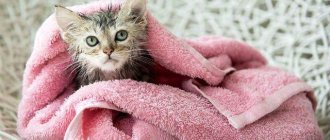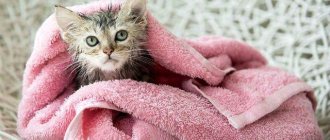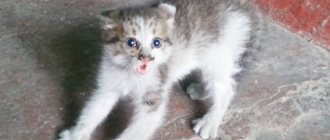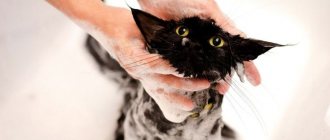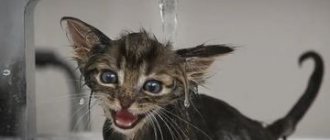Most cats avoid water treatments. However, this is one of the important components of hygiene. How correctly a kitten is bathed for the first time determines its attitude towards water for many years. Therefore, it is necessary to approach this event responsibly: choose a suitable detergent, study the advice of felinologists and, of course, be patient.
The advisability of bathing
Cats are very clean animals. They devote several hours every day to thorough licking. With the help of a rough tongue, pets are able to remove almost any dirt, as well as lost hair and skin flakes.
This desire for cleanliness has practical implications. Cats try to neutralize their own scent in order to sneak up on their prey unnoticed during the hunt.
Fear of water can also be explained. A wet pet quickly becomes hypothermic because it loses its ability to thermoregulate. Domestic cats living in “greenhouse” conditions have a rather weak immune system, which is not always able to withstand adverse factors.
If you bathe a kitten with an aggressive shampoo, the protective lubricant will disappear. Because of this, the fur becomes dry and brittle, and the skin begins to peel. Therefore, only special cosmetics are used for washing.
The kitten needs to be bathed when the following signs appear:
- the wool smells unpleasant;
- skin becomes sticky;
- abundant fatty deposits appear;
- the kitten has fleas;
- Dirt accumulates in the folds of the skin.
Cats are bathed if they are very dirty. For example, in any chemicals, soot, oil. In this case, licking the fur will cause serious harm to the health of the pet.
Contraindications to bath procedures
There are situations when it is absolutely forbidden to bathe kittens. These include:
- Illness - avoid water procedures until complete recovery.
- Vaccination – bathing kittens is prohibited for 14 days after vaccination.
- Ringworm - along with water, the infection will spread to other parts of the body.
- Surgery – After surgery, cats are not bathed until the stitches have healed.
- Severe stress - water procedures will only aggravate the condition.
First swim
The first time is the most important. If you manage to do everything correctly, do not scare the baby, and he feels pleasure from water procedures, you will save yourself from big problems in the future.
The most common mistake is giving a kitten a bath for the first time. Large, with a lot of water, it will certainly frighten the kitten. In addition, it will be very inconvenient for you to wash it at an angle, leaning over the side and putting your hands down. Be sure that as soon as you hesitate for a second, the kitten will “fly up” onto your neck or head, climbing up your arms like up a tree trunk.
It will be right if you prepare everything you need in advance: a large fluffy towel, shampoo, a bowl of water. If you have to wash the kitten alone (although it would be more convenient for two), unscrew the cap on the shampoo in advance. Prepare a couple of cotton balls soaked in sunflower oil to plug your baby's ears with, otherwise water may get into them. By the way, protect your eyes by smearing their corners with Vaseline oil.
Are you prepared? Now the most important thing is how to bathe a kitten. Take him by the withers with your hand (as the mother cat took him with her teeth) and place him in a basin of water
It doesn’t matter whether he sits or stands on all four legs, the main thing is that his posture is stable enough
Wash your baby carefully, protecting the head (especially the eyes and ears) from getting water. Do not turn on the shower - strong water pressure can frighten the kitten
Always talk to him in a normal, calm voice.
The bathing procedure should not be too long: shampoo “eats” the grease from the hair, and without it, your pet’s “fur coat” will not be shiny and smooth. There is also a risk of drying out the skin, which will become easy prey for harmful microorganisms and various infections.
After the washing is over, wrap your pet in a towel so that it is comfortable for him to breathe and look around, but under no circumstances wrap him up “with his head.” Hold the baby in your arms for a few minutes to dry him, and then put him down on the sofa - he will clean himself up. You will make sure that there are no drafts and your pet will not catch a cold.
And the last point: praise the baby for being brave and obedient (you can even play a little trick) and reward him with something tasty that he really likes. For pedagogical purposes.
At what age can you bathe a kitten?
Kittens are more vulnerable than adult animals. Their immunity is still developing, so you shouldn’t risk bathing your pet too early. During washing, the temperature regime is disrupted and the fatty film that protects the baby from pathogenic bacteria is washed off.
There is no need to bathe kittens for the first 2 months after birth. The mother takes care of their hygiene. However, many breeders wash kittens as early as 1 month. This is due to the fact that they prepare animals for sale and try to provide the kids with the most attractive appearance.
In case of severe contamination, you can carefully wash a one-month-old kitten, but only if it is accustomed to its owners and has become comfortable in the apartment. If possible, it is better to limit wiping with a damp cloth.
At 3 months, when the kitten is stronger, you can start bathing it without harm to its health. There is no need to postpone the procedure. The sooner the baby gets acquainted with water, the sooner he will get used to it.
As for at what age you can bathe a kitten with flea shampoo, it largely depends on its brand. Typically, such drugs are not used for up to two months.
However, some mild flea shampoos can be used a little earlier. It is better to consult a veterinarian first and carefully study the instructions.
DIY flea repellent
Folk remedies are sometimes used to rid a four-legged pet of parasites. They are non-toxic, safe and will not harm your pet if accidentally ingested. Flea shampoo for cats is easy to make yourself. It is prepared as follows:
- grate 30 grams of laundry soap;
- soap shavings are diluted with 15 grams of water;
- add 5 drops of cedar, lavender or peppermint essential oil to the mixture;
- the product is heated on the stove until a homogeneous mass is formed.
The resulting shampoo repels pests for 1 - 2 weeks. After bathing, it is necessary to examine your pet for allergies, since he may be intolerant to any of the components of the drug.
When choosing a product to kill fleas on a cat, you should be careful and careful. It is worth using only proven drugs and carefully monitoring your pet’s well-being after treatment, and regular prevention will allow you not to worry about the presence of harmful parasites in your furry pet.
How often to wash
Cats' natural love for cleanliness makes bathing an auxiliary, rather than a primary hygiene procedure. On the contrary, too frequent washing degrades the quality of the fur.
The frequency of washing kittens depends on the breed, coat length, and health status. As a rule, cats are bathed 6 times a year. If the animal does not leave the apartment, bath days are held once a quarter or six months.
Often you can only wash kittens of hairless breeds. They get dirty faster, so they get water treatments about once a month. Show cats are given unscheduled baths before shows.
For your information. If a cat goes outside, be sure to wash its paws after each walk.
Features of bathing sphinx kittens
The recommendations given in this section apply to all three breeds of Sphynx - Don, Canadian and Peterbald.
They will also be relevant for other hairless cats or animals with sparse fur. For example, for Cornish and Devon Rex. Cats without hair have a number of characteristics that affect the bathing procedure. The fat layer, which in ordinary animals serves as protection, in sphinxes only contaminates the surface of the animal’s body, so such kittens need to be bathed more often (in the cold season - two or three times a month, in the summer - every week).
Sphynxes have very delicate and unprotected skin, so you should not wear gloves when bathing these cats. It is best to use shampoos that are designed specifically for this breed. If for some reason this is not possible, a product for short-haired cats is also suitable. But it will need to be diluted with water in advance.
Sphinxes do not wash their heads, but rather wipe them after bathing. To do this, use a cotton pad moistened with water.
Particular attention should be paid to the skin behind the ears, areas in the corners of the eyes and near the nose.
You can dry sphinxes only with a towel, and never use a hairdryer. The fabric used to wipe such cats must be soft and fluffy. The movements when wiping must be smooth and light, without strong pressure.
For this breed of cat, keeping the room warm after bathing is very important. Experts recommend keeping a washed Sphynx in a room with a temperature of at least 25 degrees.
You can even put a special overall and a hat on the animal so that it does not catch a cold.
How to wash a kitten
Kittens are bathed using gentle products. Shampoos are not suitable for people - they are too aggressive.
Manufacturers produce cosmetics for a specific skin type:
- dry;
- fat;
- normal;
- damaged.
The most common are liquid shampoos and conditioners. They can contain both regular cleaning agents and special components. For example, to kill fleas, ticks and other parasites.
There are other types of cat shampoos:
- Dry shampoo is in powder form. Contains absorbent components: they remove excess sebum and dead skin flakes. However, it is not able to cope with heavy pollution. Used as an express remedy for show pets or kittens that are afraid of water. Suitable for use in winter as it avoids hypothermia.
- Spray shampoo - works almost the same as dry shampoo. Moisturizes and conditions the coat, helps get rid of tangles. A good option for partial bathing, when you just need to refresh your coat.
Some owners use a mixture of baby powder, cornstarch or baking soda as dry shampoo. However, this is quite risky. By absorbing moisture, starch releases gluten. If water gets on the skin, it will swell and stick to the fur.
It will most likely not be possible to comb it out - the animal will still have to be washed. The soda must be carefully removed, otherwise the cat will be poisoned by eating it while licking it.
Important. It is better to bathe animals using industrial dry shampoos. For example, brands Trixie Trocken and Mr. Gee.
When choosing a detergent, you need to take the following points into account:
- Short-haired, long-haired and hairless kittens are bathed with shampoos from separate lines.
- You should buy shampoos designed specifically for cats, or at least for cats and dogs. However, some show cosmetics are only made for dogs. It is used in extreme cases.
- Concentrated shampoos are more expensive, but are more economical. Before use, they must be diluted with water according to the instructions.
The most popular cosmetics that can be used to bathe a kitten are presented in the table.
| Effect | Name |
| Against parasites | “Disinfectant” (Bioflor company); |
| "Lugovoy" (Agrovetzaschita); | |
| “Tar” (Clandestine); | |
| "Doctor ZOO" | |
| Medicinal | "Doctor" (Goodman); |
| "BioVax for kittens"; | |
| Beaphar Shampoo Anti Dandruff | |
| For damaged skin and coat | Iv San Bernard Zeolithe |
| Strengthening and restructuring the coat | YuuP! Professional Restructuring & Strengthening; |
| Tropiclean Lime/Coconut | |
| To regulate shedding and against tangles | FURminator spray; |
| Perfect Coat Shed Control & Hairball (8 in 1); | |
| Phytoelite (Veda) | |
| Caregiver | Iv San Bernard Atami (antistatic); |
| “Gentle”, “Marine” (Agrovetzaschita); | |
| “Velvet” (CrystalLine); | |
| Artero 4Cats | |
| To add volume | Anju Beaute Texture Volume |
Important. The kitten may be hypersensitive to some component of the detergent. Therefore, after bathing you need to monitor the baby’s condition. If an allergy occurs, you should contact your veterinarian.
Indications
According to veterinary experts, there is no need to wash the animal unnecessarily. Bathing for most cats and kittens is extremely stressful, so this procedure should be resorted to only when necessary. However, there are reasons that can be considered objective indications for swimming.
The appearance of a kitten
If a kitten comes into the house, taken from a well-groomed domestic cat, then most often there is no need to bathe it.
Small pets adopted from a shelter usually do not require bathing. Employees of such organizations and volunteers, as a rule, give their charges to their new owners clean, neat and combed.
The situation is somewhat different when a kitten picked up on the street appears in the house.
In this case, the animal must be carefully examined, paying special attention to the condition of the ears, eyes, nose, abdomen and groin area.
You should inspect the fur no less carefully, running your fingers against it (you should first put on gloves). The presence of bald spots in the fur may indicate the development of lichen, and the presence of streaks and traces of pus in the area of the nose and eyes may indicate an infectious disease
After examining the pet, you need to carefully bathe it using a special antiparasitic shampoo.
If the cat gets dirty
Although cats and cats are considered clean animals, some of them do not live up to this stereotype at all. Some representatives of the cat family even manage to get dirty while in a clean house, without even leaving its confines.
Some cats' fur can quickly and frequently become dirty, matting into untidy tangles due to increased sebum production. This phenomenon is often observed in animals experiencing hormonal changes. In this case, pets also need to be bathed using a special zoo shampoo with an antiseborrheic effect.
Shedding
The period of intensive change of undercoat is one of the main reasons requiring more frequent bathing. During shedding, some of the dead hair remains and gets tangled in the fur, forming unsightly tangles and lumps. The animal is not able to cope with them on its own. Moreover, while trying to clean itself up, a shedding pet often choke on its own fur. Here it is also necessary to carry out a bath with further thorough combing of the dead undercoat.
Presence of parasites and fleas
The discovery of parasites and fleas in an animal's fur is a reason why a thorough bath should be carried out immediately
During the procedure, it is important to use a special zoo shampoo with an insecticidal effect. Such detergents help destroy parasites and prevent their further appearance.
In some cases, the procedure is repeated.
Preparation for the exhibition
Professional cat breeders know well how much effort it takes to prepare for exhibition events. Before the exhibition, purebred pets are washed using very expensive shampoos, which add shine and volume to the coat. Additionally, the wool is combed and styled with professional gels and varnishes.
The reasons listed above are the main reasons for giving your pet another bath. Veterinarians remind owners of cats and kittens who prefer to wash their animals too often that this can lead to the development of skin diseases, including massive hair loss.
How to properly bathe a kitten for the first time
If you bathe a small kitten correctly for the first time, he will not develop negative associations with this procedure. Therefore, it is so important that washing is as comfortable as possible.
Felinologists recommend adhering to the following rules:
- Do not bathe your cat after eating. Only a light snack is acceptable, but it is better to wash your pet on an empty stomach.
- It is advisable that the kitten bathe during the molting period. Washing will make the process easier, and the animal will not accumulate a lot of hair in its stomach.
- Before bathing your pet, carefully comb the fur coat and untangle the tangles. To prevent the kitten from scratching, it is advisable to shorten the claws.
- The bathroom should be protected from drafts.
- To wash your kitten for the first time, it is better to use unscented shampoo.
- At first, it is better to bathe the kitten with an assistant. One person will hold the baby, the other will perform the necessary manipulations.
- The water should not be too cold or hot. Optimum temperature +38…+40°C.
- The ears are plugged with cotton to prevent water from getting into them. If this happens, inflammation may develop.
- It is better to wet your head not with a stream of water, but with a damp sponge.
It is recommended to wash the kitten for the first time not in the bath itself, but in a small basin. This will make it easier to hold him, and the pet will feel more confident. To prevent the paws from slipping, place a rubber mat on the bottom of the container.
For your information. It is not advisable to bathe a kitten in a sink. He can escape, fall from a great height and get injured.
All necessary equipment - detergent, towels, treats, etc. - should be at hand. If your pet scratches a lot, you should take care of rubber gloves. They will protect your hands from sharp claws.
When all preparations are completed, the kitten is gradually immersed in water approximately up to the shoulders. You can allow him to hold on to the edge of the basin and at the same time pour water on him. To bathe your pet without scaring it, talk to the baby in a gentle voice during the process. A friendly intonation makes it clear that there is no threat.
Shampoo is diluted in a separate container in the required concentration and applied to the kitten’s body. The soap solution is carefully distributed with massaging movements, being careful not to wet your head. Particular attention is paid to:
- armpits;
- stomach;
- areas around the genitals;
- paws;
- places behind the ears.
More dirt accumulates here. If your pet is bathed with an antiparasitic agent, the neck is treated first to prevent fleas from escaping to the head.
Leave the shampoo on the fur for the time specified in the instructions, and then rinse the kitten with plenty of water. It is better to water the baby from a mug or wet the fur with the palm of your hand than to use a tap or shower - a powerful stream will scare the pet.
At the end, the fluffy is generously praised and treated to his favorite treat to reinforce positive associations.
How to wash representatives of different breeds
Representatives of different breeds require a special approach to bathing:
- Shorthaired Scots and Britons who devote a lot of time to grooming can be bathed once every six months.
- Long-haired cats, such as Persian or Siberian cats, need to be washed every 2 months.
- White kittens are bathed with whitening shampoos.
- Detergents for long-haired breeds are not used for short-haired kittens with abundant undercoat.
- It is not advisable to bathe kittens of white and blue colors, particolors and silver pets with herbal shampoos.
- To wash Sphynxes and other hairless cats, specialized shampoos are used that care for the skin. The head is wiped with sanitary napkins.
- Products for adding volume are not suitable for animals with tight-fitting hair without undercoat (Siamese, Oriental, Abyssinian cats, etc.).
How to care for a Canadian kitten at home
It is recommended to purchase a Sphynx kitten at the age of 3 months. The animal's insufficient age will create many problems. And by the age of 3 months, the baby is already toilet trained, eats on his own, and parting with the cat will not be painful for him.
The breeder must give recommendations on care and feeding rules. The new owner should maintain contact with the breeder in order to get professional advice if necessary and not seek rash advice from outsiders.
It is imperative to maintain the same nutrition by specifying the kitten’s habits and favorite foods. The same applies to the feeding regime. The main nuances of the establishment of Sphynx kittens are as follows:
- 6 meals a day until the age of 6 months;
- 3 feedings a day up to 9 months;
- after 9 months of feeding 2 – 3 times a day;
- mandatory training in bathing and other grooming procedures.
A pet of this breed will never go into a dirty litter tray and will eventually choose another place in the house. It is useless to scold for this, since a dirty tray is the owner’s fault. The filler should not be allergenic. From the first days, the kitten needs to be shown the place of the tray, so that later he knows and understands it.
How to teach a kitten to bathe
Bathing is a serious stress for your pet. To avoid health problems and not to injure the baby’s psyche, he needs to be prepared before the first wash.
Important. Kittens subtly sense people's moods. If the owner is nervous, the anxiety will be transmitted to the pet. Therefore, before swimming you need to calm down and relax.
First, the kitten is placed in a dry bath and they try to play with it. He needs to understand that it is safe here. When the baby gets comfortable, open the tap. Some pets themselves show interest and begin to play around with a thin stream of water.
The process is repeated several times until the kitten becomes absolutely calm about the procedure. Cats that cannot get used to water can be bathed in mesh bags. They restrict the movement of animals, but do not prevent water and detergents from entering the body.
How to dry
After bathing, the pet is dried with a terry towel and wrapped in a soft cloth. You should not rub the fur vigorously - it will become very tangled.
Then the kitten is released. He begins to actively lick himself and dries his coat on his own. The rough tongue combs the hairs and evenly distributes protective lubricant over them.
If your baby trembles for more than 5 minutes after bathing, you should use a hairdryer. The same applies to long-haired breeds. However, the baby must first be introduced to this device, otherwise he will be scared. The air flow should be warm, but not hot. During the drying process, the fur is combed in the direction of hair growth.
Important. For 12 hours, the kitten should be in a warm room without drafts and not go outside.
If you bathe a kitten correctly, it will not be afraid of water. It is important to teach your baby hygiene from childhood and use suitable detergents - then the procedure will not cause much trouble.
Selecting a detergent
Human products should not be used in caring for animals. Shampoos intended for dogs are also not suitable for cats.
All detergents are made taking into account the characteristics of the hair, so for mustachioed purrs their own lines of hygiene products are produced, which can be purchased at a veterinary pharmacy.
Types of shampoos for cats
| Type | Peculiarities |
| Liquid | They are considered the most effective for cleaning wool. Contains herbal extracts and vitamin supplements Several varieties are available:
|
| Dry | The powder product allows you to avoid the bath procedure and saves you in situations where cats are terrified of water. Shampoos of this type relieve your pet of dead epidermis and surface dirt, but cannot cope with severe dirt. The advantages of these shampoos are that they can be used more often than liquid ones without damaging the sebaceous glands |
| Sprays | These shampoos, like dry shampoos, do not require the use of water. Easily applied to the body and distributed evenly over it. They have antistatic properties and make combing easier. Recommended as an intermediate product between water procedures, as they cannot provide complete hair care. |
Professionals highlight another type of shampoo for cats - with a therapeutic effect. They help rid your pet of insects and are a good preventive measure that prevents pest infestations.
When choosing any type of detergent for a pet, you should also pay attention to such a nuance as the age category: shampoo for an adult animal is not suitable for a kitten
Popular brands of industrial products
The question of which shampoo to choose for your kitten should be discussed with your veterinarian or pharmacy pharmacist.
- liquid shampoos: Le artis, AVZ-Gentle;
- dry: Biofan zoo, Mr.gee;
- sprays: Gold Premium, FURminator.
As for medicinal products, an individual approach is required. You can’t do without consulting a specialist.
From traditional medicine
There are many ways to wash cats using medicinal folk remedies to rid animals of fleas using improvised means.
The following compositions are used:
- camphor alcohol with vinegar and cologne;
- baby soap with calendula decoction, grated onion and egg yolk;
- dry wormwood in saline solution, etc.
Traditional healers recommend sulfur or iodine baths for lichen kittens. But these remedies are justified only if the animal is allergic to industrial products or there are so many fleas that simple bath procedures cannot cope with them.
